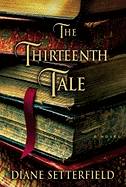
 "It was November. Although it was not yet late, the sky was dark when I turned into Laundress Passage. Father had finished for the day, switched off the shop lights and closed the shutters; [it was while I was] about to turn my key in the door, that I first saw the letter." A promising opening, since ominous tales are better set in the winter months, and The Thirteenth Tale is well-suffused with shadowy skies, chilling rain and muffling snow. The letter is from Vida Winter, the world's most famous living author, as well-known for her secrecy as for her novels. In the letter, she asks Margaret Lea, a plain, quiet London bookseller's daughter ("people hardy ever notice me for long enough to ask me personal questions"), to consider writing her biography. Margaret has penned a slight book that leads Miss Winter to believe she has an unusual understanding of sibling relationships, particularly twin relationships. The young woman is intrigued, since the author fascinates her. When Margaret was a child, books were everything to her; as an adult, she has a nostalgic yearning for the lost pleasure of books, which she rediscovered when she read Vida Winter's famous short story collection, Thirteen Tales of Change and Desperation: "And during this time, these days when I read all day and half the night, when I slept under a counterpane strewn with books . . . the lost joys of reading returned to me. Miss Winter restored to me the virginal qualities of the novice reader, and then with her stories she ravished me."
"It was November. Although it was not yet late, the sky was dark when I turned into Laundress Passage. Father had finished for the day, switched off the shop lights and closed the shutters; [it was while I was] about to turn my key in the door, that I first saw the letter." A promising opening, since ominous tales are better set in the winter months, and The Thirteenth Tale is well-suffused with shadowy skies, chilling rain and muffling snow. The letter is from Vida Winter, the world's most famous living author, as well-known for her secrecy as for her novels. In the letter, she asks Margaret Lea, a plain, quiet London bookseller's daughter ("people hardy ever notice me for long enough to ask me personal questions"), to consider writing her biography. Margaret has penned a slight book that leads Miss Winter to believe she has an unusual understanding of sibling relationships, particularly twin relationships. The young woman is intrigued, since the author fascinates her. When Margaret was a child, books were everything to her; as an adult, she has a nostalgic yearning for the lost pleasure of books, which she rediscovered when she read Vida Winter's famous short story collection, Thirteen Tales of Change and Desperation: "And during this time, these days when I read all day and half the night, when I slept under a counterpane strewn with books . . . the lost joys of reading returned to me. Miss Winter restored to me the virginal qualities of the novice reader, and then with her stories she ravished me."Margaret journeys to Miss Winter's home, appropriately situated on the Yorkshire moors. Greeted by the enigmatic housekeeper, she enters a place that is utterly silent, every floor carpeted and the walls baffled by damask drapes. "Just as blotting paper absorbs ink, so all this wool and velvet absorbed sound, with one difference: Where blotting paper takes up only excess ink, the fabric of the house seemed to suck in the very essence of the words themselves." After she meets the reclusive author, and decides to take the commission, Miss Winter is reluctant to speak. She begins, "Angelfield was odd . . . Isabelle Angelfield was born during a rainstorm." Then she stops, so used to hiding the truth that she cannot speak for some time, but finally continues with the story of Isabelle and her equally odd and sadistic brother Charlie, Isabelle's twin children, Emmaline and Adeline, and their caretakers. Emmaline had the goodness of two children, Adeline the wickedness of two. "The twins were . . . strange all through, right into their very hearts." The story of this peculiar and destructive family includes a governess, a doctor, a housekeeper and a gardener, an engaging character named Aurelius Alphonse Love, and perhaps a ghost or two.
Diane Setterfield sets a marvelous stage for this moody, haunting mystery. As Margaret fixes her room up for writing, she lays out a ream of paper and 12 pencils, and then screws a pencil sharpener to the edge of the desk; the implements are reminiscent of an earlier, more innocent time. However, as she sharpens the pencils, she watches her reflection in the dark window, and sees a pale other self: "But where my chair was red, hers was gray; and where my chair stood on an Indian rug, surrounded by light gold walls, her chair hovered spectrally in an undefined, endless plane of darkness in which vague forms, like waves, seemed to shift and breathe." The familiar and unfamiliar blend into an unsettling puzzle; romance and terror enter Margaret's life as her sorrow and Miss Winter's intertwine in this tale of secrets and their unveiling. Setterfield pays tribute to traditional Gothics when Margaret says, "I read old novels. The reason is simple: I prefer proper endings." The Thirteenth Tale refreshes the classic style in a satisfying story with a very proper ending.--Marilyn Dahl

